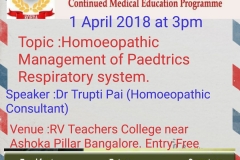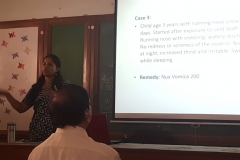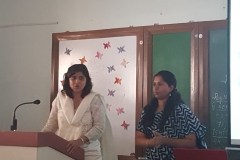Prof. Dr. H L Swamy and Dr. Trupti Pai (BHMS), were the speakers. Dr. Trupti Pai, completed her BHMS in 2005 from Smt. Chandaben M Patel Homoeopathic College, Mumbai. Prof. Dr. H L Swamy spoke about KPME Act and how rare remedies become common remedies when we start using it, in reference to URTI.Dr.Trupti Pai spoke on Homoeopathic Management of Pediatric Respiratory Diseases.
The CME started with basics of Anatomy and Development of paediatric respiratory system followed by treatment with Homoepathy by Dr. Trupti Pai. Emphasis in the presentation was on the following :
Discussion of cases wherein remedy was selected on basis of causative factor; example,
Natrum Mur Child:
The second speaker, Prof. Dr. H L Swamy, briefed on KPME Act explaining the new amendments on pollution control board and importance of KPME Act. He also introduced the audience to Biomedical Waste Management team from Satva health solutions.
Prof. Dr. Swamy later presented remedies for URTI. He beautifully presented rare remedies which become common remedies once we start using them regularly for URTI diseases such as;
The CME was concluded by vote of thanks by Dr Deepa Raje and Dr Chiranth. The reminder announcement regarding one day seminar by Dr.Parinaz Humranwala on 29th April, was made, requesting attendees to enroll for the same.
The CME started with basics of Anatomy and Development of paediatric respiratory system followed by treatment with Homoepathy by Dr. Trupti Pai. Emphasis in the presentation was on the following :
- Be a keen unprejudiced observer. Most of the pediatric acute and chronic case taking depends on carefully observing the child, his/her behaviour.
- Causative factor /Ailments from: The triggering agent or the causative factor is very important on understanding the occurrence of the symptoms especially in acute cases.
- Description of episode: the way the symptom appears or is experienced , history from mother , observing the child during the episode or behaviour in the clinic.
- Modalities: aggravation or amelioration of symptoms. All of the above helps select the appropriate remedy All of the above helps select the appropriate remedy with effective results.
Discussion of cases wherein remedy was selected on basis of causative factor; example,
- A case of acute exacerbation of chronic bronchitis where the causative factor was drinking Ice Cold water improved very well with Mephitis 30.
- Sudden onset of sore throat after exposure to cold air improved by Belladonna 200.
Natrum Mur Child:
- never contended ,always complaining
- intelligent neat and clean
- angry on small things /contradiction
- has few friends due to nagging behavior
- does not talk to doctor or give his symptoms
- Talks in monosylabbles.
- pleasing and friendly outside but domineering at home
- will have friends or play with kids younger than him so that can boss over them
- fear being alone needs company
- Stranger anxiety right from birth
- will observe the surrounding before being comfortable.
The second speaker, Prof. Dr. H L Swamy, briefed on KPME Act explaining the new amendments on pollution control board and importance of KPME Act. He also introduced the audience to Biomedical Waste Management team from Satva health solutions.
Prof. Dr. Swamy later presented remedies for URTI. He beautifully presented rare remedies which become common remedies once we start using them regularly for URTI diseases such as;
- Cina for Coryza only in noon
- Thuja for Cough only during stools
- Nux vom , Belladonna , Sepia for complaints after first haircut
- Nux Vom for Coryza after sitting on a cold stone
- Sambucus for acute asthma with sweat and many more such prescriptions.
The CME was concluded by vote of thanks by Dr Deepa Raje and Dr Chiranth. The reminder announcement regarding one day seminar by Dr.Parinaz Humranwala on 29th April, was made, requesting attendees to enroll for the same.



